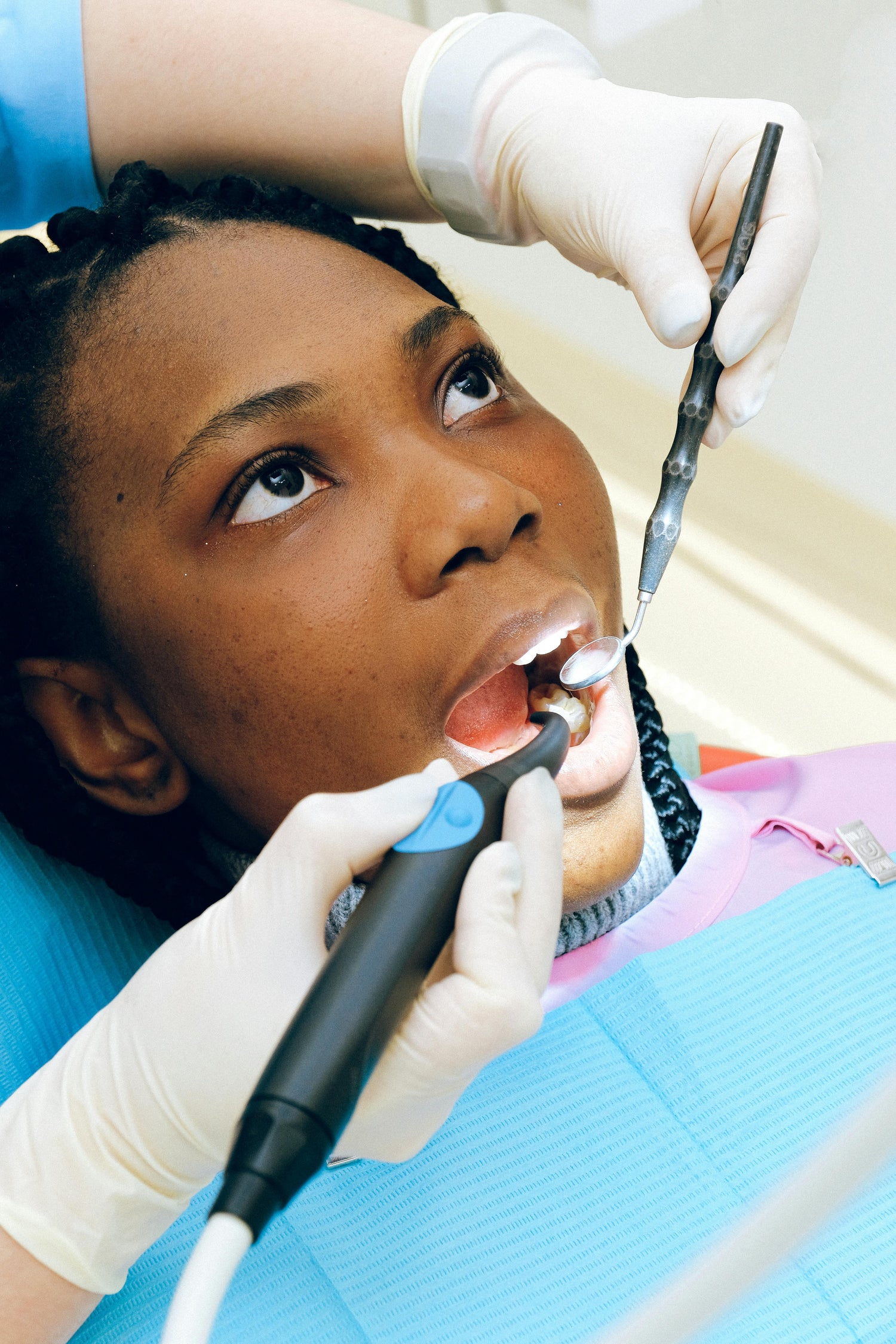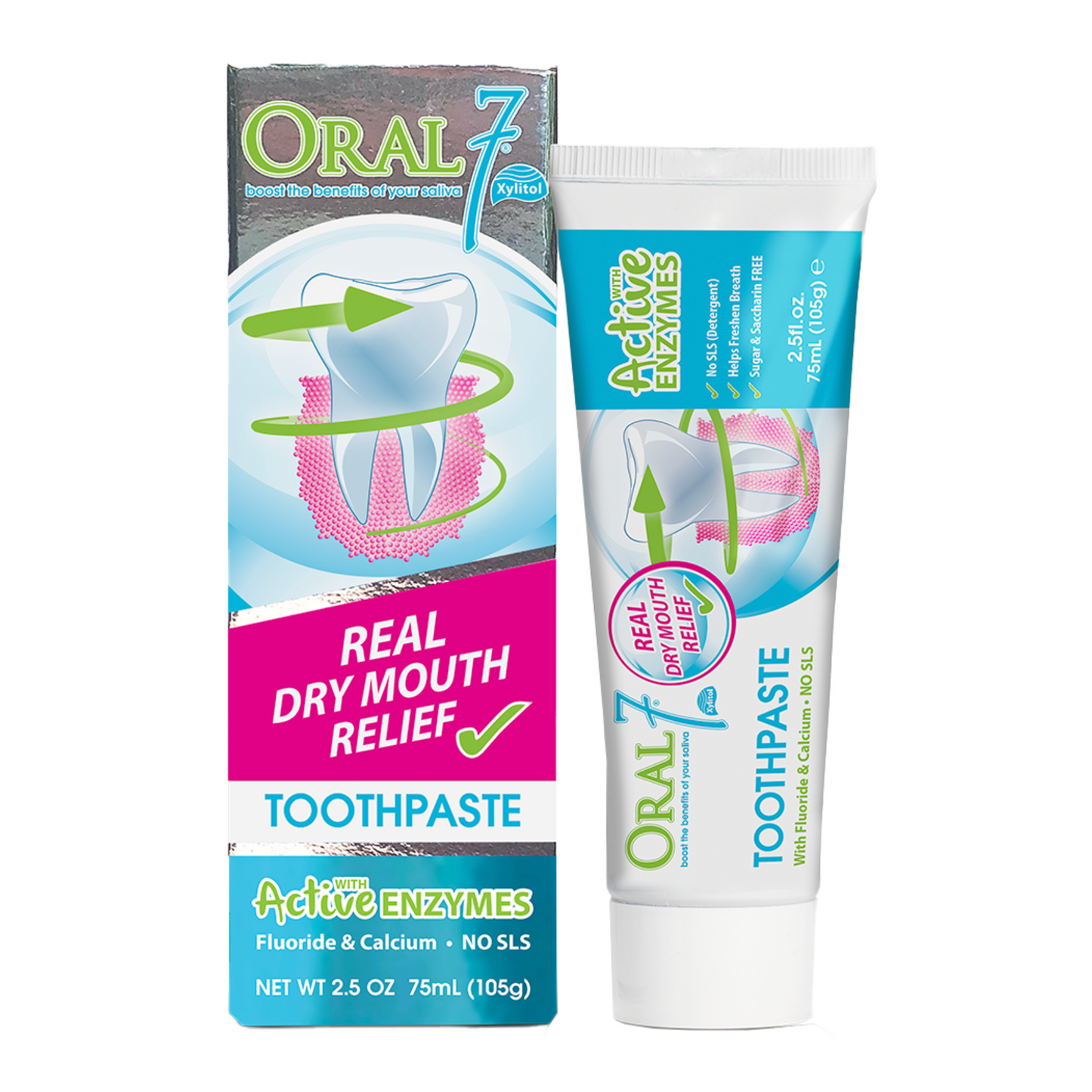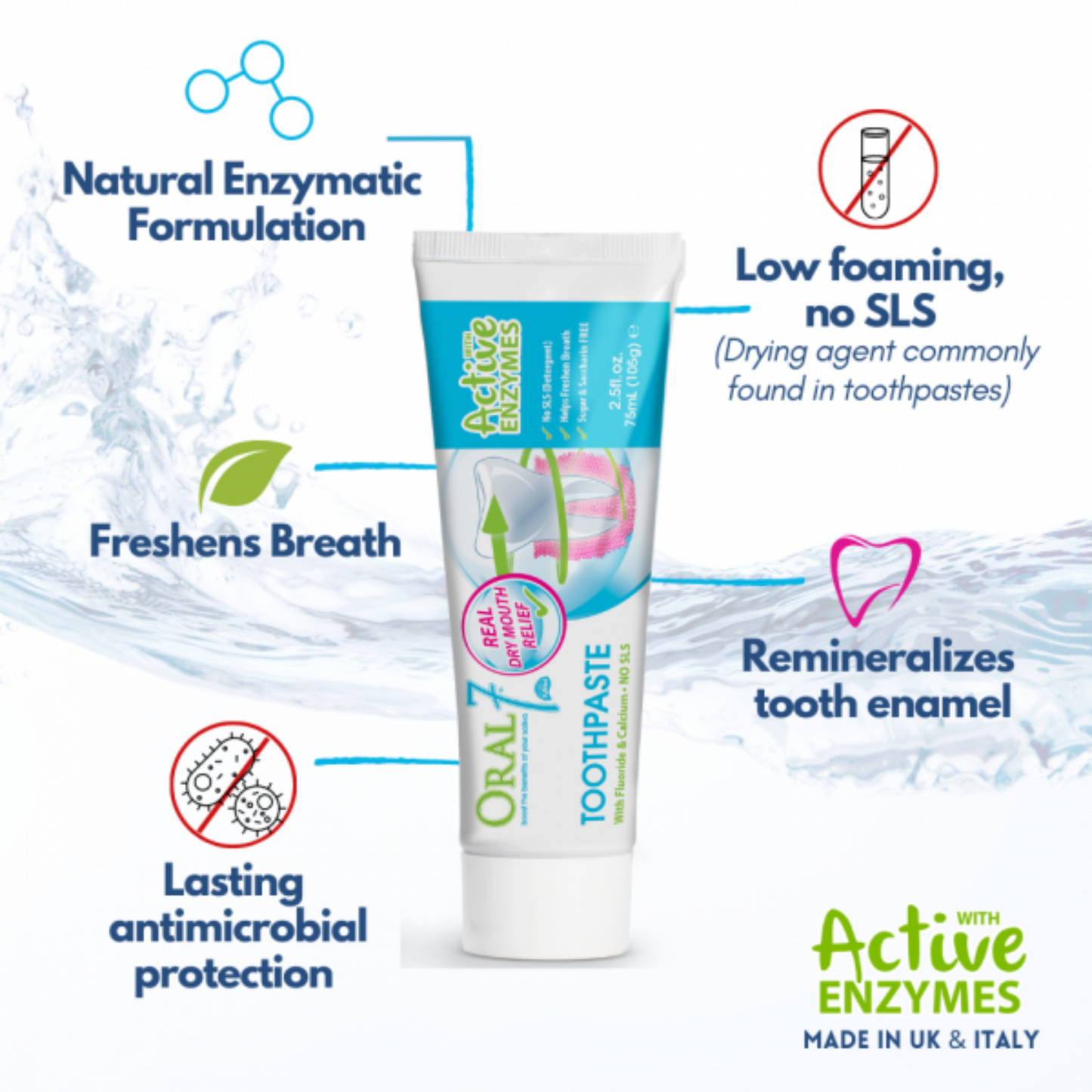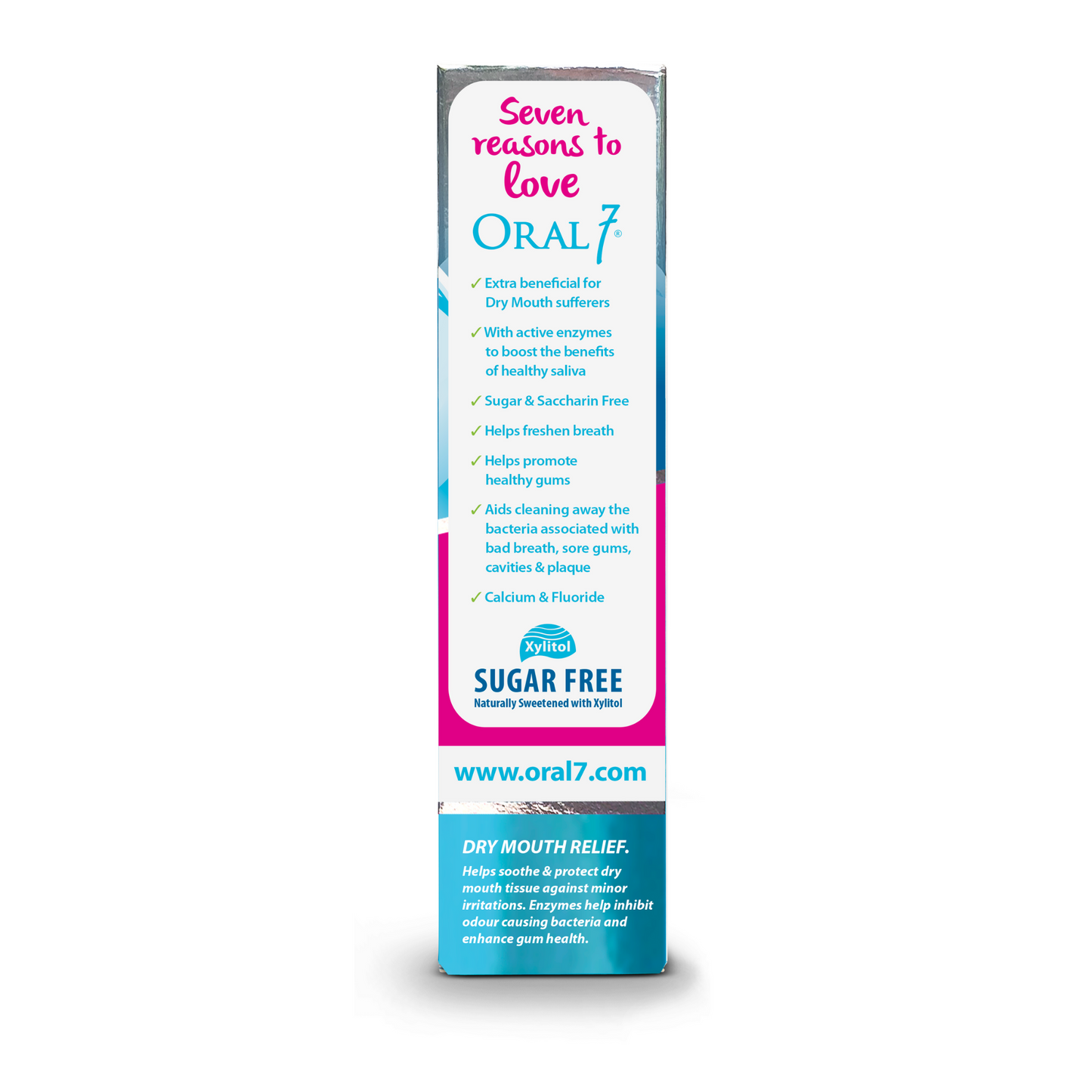
Can I use Oral7 even if I do not have dry mouth?
Yes, Oral7® contains natural enzymes like those in normal healthy saliva which are essential in the prevention of caries and gingivitis.

Why does Oral7 toothpaste not foam like other toothpastes?
Because it does not contain any Sodium Lauryl Sulphate, a synthetic foaming detergent that can contribute to Dry Mouth.

Why is Oral7 good for dry mouth relief?
We use a natural, enzymatic formulation that lubricates and protects mouth tissue against minor irritations for lasting comfort.
General FAQs
Should I continue to use Oral7® on a daily basis once my oral health has improved?
Yes, it is important to continue the daily care to keep your mouth healthy and to reduce the chances of cavities and gum disease.
Will Oral7® affect my medication?
No, the Oral7® range will not adversely affect any medications being taken.
Please note that it is important that you never stop any other medicines or products that your health team recommend to you, if in doubt ask your team.
Where is the Oral7® range produced?
The Oral7® range is produced in the UK under strict regulations and is based on the successful and widely accepted dry mouth products sold in Australia over the last twenty years.
From what age can I use the ORAL7® Tiny Teeth toothpaste for my baby?
From 6 months, brush and massage every day with Oral7® Tiny Teeth. Use the finger toothbrush to clean the first teeth and massage the gums to help prevent cavities.
From what age can I use the ORAL7® KIDS toothpaste?
From the age of 3-12 years old. Oral7® KIDS toothpaste has a great “tutti frutti” taste which kids love and is rich in calcium.
Ingredient FAQs
Does Oral7® contain Gluten?
No.
Is Glucose Oxidase a sugar? How does it work in the Oral7® products?
No! Oral7® contain all the components needed to recreate the Salivary Peroxidase System in dry mouths.
The Salivary Peroxidase System needs the following components to be present: salivary peroxidase, thiocyanate, hydrogen peroxide and oxygen.
Glucose Oxidase is an enzyme that acts on the glucose produced from food ingestion. It is included in the formulation to ensure the production of hydrogen peroxide.
Glucose Oxidase needs Beta D Glucose to help recreate the salivary peroxidase system in the mouth.
Glucose is made up of Alpha D Glucose and Beta D Glucose.
Glucose Oxidase uses the Beta D Glucose to create hydrogen peroxide – a vital component of the Salivary Peroxidase System. The remaining Alpha D Glucose is then converted to Beta D Glucose that is in turn used by Glucose Oxidase.
There is 2.5 mg of Glucose per 25g of toothpaste, (equivalent to 1 grain of sugar). This quantity is totally used by Glucose Oxidase to produce the required hydrogen peroxide.
Is Sorbitol a sugar?
No! Sorbitol is a naturally occurring sweetener used in drinks and confectionary in place of sugar. It is a non-active ingredient in Oral7® products and is used as a binding agent.
Large quantities of sorbitol would have to be ingested to cause diarrhea, but to have this effect it is necessary to ingest 20 -50g per day.
In one whole tube of Oral7 there is 24.5g of Sorbitol.
What is Xylitol? Does Xylitol have a beneficial effect?
Xylitol is a naturally occurring sweetener found in berries, fruits and mushrooms. It also occurs in small quantities in the human body.
Xylitol is useful and suitable in dental products because bacteria cannot metabolise it. This means it is a non-cariogenic sweetener and does not promote dental caries.
There is also evidence to suggest that it helps to prevent the effects of cariogenic bacteria in the mouth.
Why do Oral7® products contain Dextrose?
Oral7® have been scientifically formulated to include all the elements necessary to ensure the salivary Peroxidase System is active in the mouth of Dry Mouth Sufferers.
One essential component of the Salivary Peroxidase System is Hydrogen Peroxide that is secreted by the bacteria created from food consumption. To be sure that the complete Salivary Peroxidase System is in the Oral7® products – including Hydrogen Peroxide – it is necessary to include Glucose Oxidase and Dextrose in the formulation.
Dextrose is a compound containing Alpha D Glucose and Beta D Glucose molecules in equal balance with each other.
In Oral7® Toothpaste the Glucose Oxidase gradually uses the Beta D Glucose molecules to produce the essential Hydrogen Peroxide.
Since there must be equilibrium between the Alpha D Glucose and the Beta D Glucose, as the quantities of Beta D are taken up by Glucose Oxidase, so the same amount of Alpha D is converted to Beta D, thus maintaining the equilibrium.
Glucose Oxidase the again uses the newly converted Alpha D and the cycle of events continues in the mouth, helping form the salivary Peroxidase System.
The amount of dextrose in the products is minimal – 2.5mg per 1g – equivalent to approx 1 crystal of sugar, and the formulation ensures all the dextrose is completely used up by Glucose Oxidase to produce Hydrogen Peroxide.
Similar enzymatic products have been used in the US and other countries for the past 17 years without any known reports of adverse effects with respect to the dextrose ingredient.
What is Lysozyme?
Lysozyme is a salivary protein that can break down the bacterial cell walls causing them to die.
Lysozyme can kill pathogenic bacteria without affecting healthy oral flora and thus helps stabilize the oral environment.
Lysozyme is also known to have an effect on oral yeast.
What is Lactoferrin?
Lactoferrin is a salivary protein and is one of the most important antimicrobial agents in the mouth.
It can bind to the molecule of excess iron that the bacteria would otherwise use to grow.
It is secreted by salivary glands and gingival fluid.
Lactoferrin is also known to have a bactericidal activity that enables the molecules to kill some oral microbes by binding to the cell membrane and causing cell death.
Why is Sodium Monophosphate used in Oral7® Toothpaste and what is the amount? Why is there no fluoride in the Oral7® Gel and Mouthwash?
Studies have shown that the only fluorides compatible with enzyme action are sodium monofluorophosphate and calcium fluoride.
Restricted use of fluoride is recommended in order to avoid the possibility of internal problems due to ingestion of ORAL7® Gel and Oral7®mouthwash.
Oral7® may be used day and night by Dry Mouth sufferers and will consequently be ingested.
Oral7® Mouthwash can and may be ingested and is therefore not suitable as a method of providing fluoride. There are no dangerous side effects if the Oral7® Mouthwash is swallowed.
There is approximately 1000 -ppm (0.76%ww) fluoride in the Oral7® Toothpaste.
Could the flavourings cause allergies?
Studies have shown that the only It is possible that anyone can have an allergic reaction to any particular substance, but Oral7® contain mostly natural ingredients that have been carefully selected to be gentle on sore mouths.
Oral7® Gel: There are no flavourings in ORAL7® Gel, with the sweetness being provided by xylitol and partly by sorbitol.
Oral7® Mouthwash: Mentha Piperita (Peppermint Oil)* Contains: Limonene
Oral7® Toothpaste: Mentha Piperita (Peppermint Oil)* Contains: Limonene, Menthol
Please check to see if you are allergic to any of the above ingredients.
(*) Some salycilate allergic people are allergic to peppermint oil.
Oral7 UK
Oral7® Moisturising Toothpaste



Usage FAQs
When should I start seeing positive results from using the Oral7® System?
You should see results within a few days – depending on the severity of the Dry Mouth condition, it may take up to 10 days.
The Oral7® range of products are more effective when used together as a system. Due to the sensitive nature of the enzymes contained within the Oral7® products, if used in conjunction with other products, especially alcohol based mouthwash, the enzymes will be destroyed and the products will be less effective.
Do the Oral7® products have an effect on Candida?
Where Candida is already present in the mouth, Oral7® does not present a cure. However, used regularly, the Oral7® products will help to inhibit the growth of Candida by keeping the oral environment balanced and therefore decreasing the risk of Candida.
Oral7® can safely be used in conjunction with medications for the control of thrush in the mouth.
The Salivary Peroxidase System: How does it work?
Enzymes in saliva activate a reaction between thiocyanate (a substrate found in saliva) and hydrogen peroxide (produced by bacteria in the mouth)and oxygen.
This creates hypothiocyanite, saliva’s natural antibacterial agent.
Hypothiocyanite inhibits the bacteria that can lead to deterioration in oral health. In healthy mouths, this continuous cycle is always present due to saliva and is vital for good oral health.
What are the pH levels of the products? Does the pH of the mouthwash contribute to demineralization?
Oral7® Toothpaste – 5.7 to 6.3 and Oral7® Mouthwash – 5.4 to 5.6
Oral7® Gel – 6.4
It is perfectly normal for the pH in the mouth to fluctuate. If teeth were subjected continuously to a pH of less than 5.5, demineralization could occur. However, Oral7® Mouthwash is used for 30 seconds twice a day and poses no threat to tooth enamel.
The recommended regime is to use all three Oral7® products together as a complete oral hygiene routine, to deliver optimum pH for lactoferrin and lysozyme to work effectively.
Oral7® Gel, applied after using the Oral7® Toothpaste and Oral7® Mouthwash, works to maintain a stable oral environment.
In microbiological terms, lactoferrin and lysozyme present in saliva exert an anti-bacterial and bactericidal action more effectively at a pH between 5 and 5.5. Microbiologists consider that this acid barrier presents one of the most important defenses against infection.
Oral7® Mouthwash, in addition to Lactoperoxidase, contains lactoferrin and lysozyme. It is for this reason that ORAL7® Mouthwash was formulated with a pH of 5.4.
One of the main problems in controlling bacteria present in Dry Mouths is how to balance the optimum pH for inhibiting bacteria – which lends itself towards acidic – and at the same time ensuring protection against demineralization.
Oral7® as a complete Dry Mouth System, have been very carefully formulated to offer dry mouth sufferers a means of alleviating the symptoms of their condition in a way which acts as closely as possible to the protective action of their own saliva.
Enzymatic products with the same Enzymatic System as Oral7® have been in use for over 20 years with no recorded demineralization.
Is there a chance that oral bacteria could become resistant to the Oral7® products?
No! Because Oral7® contains only natural ingredients which work to boost and replenish the natural defense system present in saliva.
The bacteria cannot become resistant because they are inhibited rather than destroyed – just as they do not become resistant to saliva.
Why should the caps be closed after each use?
- The enzyme system in Oral7® are activated by oxygen.
- An open cap may cause the first few centimeters of product to be less effective or even inactive.
Product FAQs
Oral7® Moisturising Mouthwash
There are no dangerous side effects when the ORAL7® Mouthwash is swallowed.
It is not recommended that you dilute the Oral7® Mouthwash because you will lessen the effectiveness of the enzymes. However, for those who feel the Oral7® Mouthwash has too strong a taste it may be diluted up to 50%. Dilute and use only what you need at the time.
The product is designed to be used as often as required – especially after brushing and before bed.
The Calcium in Oral7® Mouthwash helps to harden enamel on your teeth and also helps to neutralize acids in the mouth.
The Oral7® Mouthwash is flavored with natural peppermint oil.
Oral7® Moisturising Toothpaste:
Absolutely, anyone use Oral7® Moisturising Toothpaste, even if they don’t have Dry Mouth.
Oral7 natural enzymes are normally found in saliva and are essential in the prevention of caries and gingivitis, while promoting a healthy oral flora.
The Radioactive Dentine Abrasion (RDA) level for Oral7® Moisturizing Toothpaste is 55. As the acceptable standard level of abrasion is set by the ADA as 100. Pastes over 100 are considered more abrasive and those under 100 are considered safe for daily use.
The toothpastes with very low RDA’s are considered gentle and safer to use on CEJ’s, cementum and dentine (e.g. exposed root surfaces).
Oral7® Moisturising toothpaste is flavoured with Mild Peppermint.
Oral7® Moisturising Gel:
Oral7® Gel is perfectly safe to swallow as it is made up of naturally occurring salivary enzymes. Swallowing will assist in moisturizing a dry throat.
Oral7® Gel is sweetened with Xylitol that is produced by the body during normal metabolism.
Oral7® Gel will not adversely affect any other medications being taken.
You can apply Oral7® Gel with your finger or a sterile swab, on the inside of cheeks, tongue and gums and under the tongue.
Oral7® Gel can lubricate and maintain moisture for up to 6-7 hours. It is used as a saliva substitute and applied before eating, throughout the day and before sleeping.
Yes, Oral7® Gel is effective and safe placed on the inside of dentures to assist with suction. Dentures need to be tight fitting for this to be effective, otherwise a denture adhesive such as Fittydent Denture Adhesive is recommended.
Featured collection
-
Oral7® Moisturising Mouthwash - 2 sizes
Regular price From £6.99 GBPRegular priceUnit price per -
Oral7® Moisturising Toothpaste
Regular price £6.49 GBPRegular priceUnit price per -
Oral7® Moisturizing Mouth Gel
Regular price £9.99 GBPRegular priceUnit price per -
Oral7® Moisturising Mouth Spray
Regular price £6.99 GBPRegular priceUnit price per






